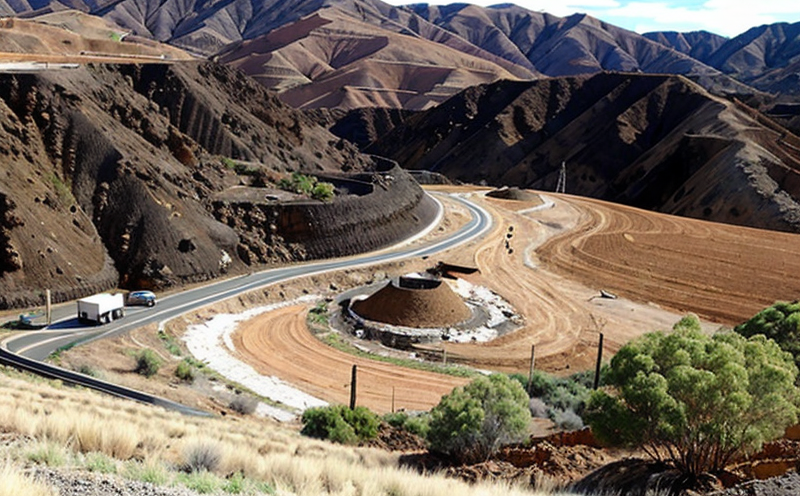DIN 38414 Leachability of Restored Soil Materials Testing
The DIN 38414 standard specifies procedures to determine the leachability of restored soil materials in mining rehabilitation projects. This testing is crucial for ensuring that the engineered land and mine sites are safe, sustainable, and environmentally friendly post-rehabilitation.
Leaching refers to the process where soluble compounds move from soil particles into water or air due to rainfall, runoff, or irrigation. Controlling leachate is vital in preventing contamination of surface water bodies and groundwater resources. This test helps mining companies comply with environmental regulations and ensures that rehabilitated sites are stable and resilient.
The testing procedure involves the use of a column apparatus where soil samples are placed under controlled conditions to simulate natural rainfall. The leachate is collected at regular intervals for analysis. The primary goal is to identify potential contaminants like metals, nutrients, or other harmful substances that could migrate into surrounding ecosystems.
Specimen preparation typically includes sampling the restored soil from various depths and locations across the rehabilitated area. Samples are then air-dried, sieved if necessary, and homogenized before being packed into a column for testing. The column is designed to mimic natural conditions as closely as possible, including factors like porosity, texture, and moisture content.
Instrumentation used in this test can include gravimetric or volumetric methods for measuring the volume of leachate collected over time. Analytical chemistry techniques such as ICP-MS (Inductively Coupled Plasma Mass Spectrometry), AAS (Atomic Absorption Spectroscopy), and HPLC (High Performance Liquid Chromatography) are often employed to quantify the concentrations of various elements present in the leachate.
The standard specifies detailed acceptance criteria based on the maximum allowable limits for specific contaminants. These limits vary depending on the type of soil, its intended use post-rehabilitation, and local environmental regulations. Compliance with these standards ensures that the rehabilitation efforts are effective and sustainable.
This test is particularly important in sectors like mining where large-scale land disturbances occur. By conducting this test at regular intervals throughout the rehabilitation process, companies can monitor changes over time and make necessary adjustments to improve outcomes. This proactive approach enhances stakeholder confidence and supports long-term environmental stewardship.
- Column Design: DIN 38414 specifies a column height-to-diameter ratio of 5:1 to simulate natural conditions accurately.
- Sampling Depths: Samples are taken from at least three different depths within the restored soil layer.
- Moisture Content: The moisture content is controlled to match field conditions, typically between 20% and 30% by weight.
- Duration: Testing usually lasts for a minimum of seven days or until stable concentrations are achieved.
In conclusion, the DIN 38414 leachability test is an essential tool in ensuring that mine rehabilitation projects meet both regulatory requirements and sustainability goals. By providing detailed insights into the behavior of restored soil materials under real-world conditions, this testing contributes significantly to environmental protection and responsible resource management.
Eurolab Advantages
EuroLab provides comprehensive support for DIN 38414 compliance with a suite of advanced facilities and expertise. Our state-of-the-art laboratories are equipped with the latest analytical instruments, ensuring precision and accuracy in every test.
- ISO/IEC 17025 Accreditation: EuroLab is ISO/IEC 17025 accredited, guaranteeing that all our tests meet international standards for reliability and validity.
- Experienced Professionals: Our team comprises highly skilled scientists with extensive experience in environmental testing, ensuring thorough and reliable results.
- Robust Quality Control: We maintain strict quality control measures to ensure consistent test outcomes across all projects.
- Comprehensive Reporting: EuroLab provides detailed reports tailored to the specific needs of our clients, including recommendations for improvement where necessary.
EuroLab also offers additional services such as soil remediation planning and environmental impact assessments. Our multidisciplinary approach ensures that we address all aspects of mine rehabilitation comprehensively.
Why Choose This Test
The DIN 38414 leachability test is a critical component in the evaluation of mine rehabilitation projects. It helps to ensure that the rehabilitated land remains stable and free from contaminant migration, which is essential for long-term sustainability.
One of the primary benefits of this test is its ability to provide early warnings of potential issues during the rehabilitation process. By identifying any problematic areas at an early stage, companies can address these concerns promptly, saving time and resources in the long run.
The test also contributes significantly to regulatory compliance. Many countries have strict environmental regulations that mandate leachability testing as part of mine closure plans. By conducting this test, mining companies demonstrate their commitment to environmental responsibility and sustainability.
Moreover, the DIN 38414 standard is recognized internationally, making it easier for mining operations to align with global best practices. This recognition enhances a company’s reputation and can be beneficial in securing future contracts or investments.
EuroLab’s expertise in this area ensures that clients receive accurate and actionable results. Our team of experts works closely with clients throughout the testing process, offering guidance and recommendations for improvement whenever necessary.
Competitive Advantage and Market Impact
- Reputation: EuroLab’s reputation as a leading provider of environmental testing services enhances client relationships and opens doors to new opportunities.
- Differentiation: By offering DIN 38414 compliance, we differentiate ourselves from competitors who may not offer the same level of expertise or reliability.
- Client Satisfaction: High-quality results and reliable reports contribute directly to client satisfaction, leading to repeat business and referrals.
- Market Leadership: Our commitment to sustainability and environmental responsibility positions us as leaders in our field. This leadership is reflected in the growing number of clients choosing EuroLab for their testing needs.
The ability to conduct this test effectively sets us apart from competitors, providing a clear advantage in an increasingly competitive market. By ensuring that mine rehabilitation projects meet stringent environmental standards, we contribute to healthier ecosystems and more sustainable development practices.





